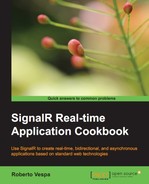When a connection is made, a transport strategy must be put in place in order to properly move bits back and forth between the client and the server. SignalR can choose among different transport options as follows:
- WebSocket: This is an HTML5-related protocol that provides full duplex communication channels over a single TCP connection and is available in modern web browsers and web servers
- Server-Sent Events: This is a strategy based on the EventSource HTML5 support that allows a server to stream messages to the connected clients
- Forever Frame: This is a strategy based on the use of a hidden iframe element, where the chunked encoding HTTP feature is used to send an indefinitely long stream of bytes
- Long Polling: This is quite a basic technique that involves the opening of an HTTP connection and keeping it artificially alive to create the illusion of a persistent connection
Each one of these strategies is based on a specific underlying technology, which may or may not be available according to the specific browser used and to the capabilities of the web server in place. SignalR will try to use WebSocket whenever possible, and if it's not available, it will gracefully fall back on the remaining ones until it picks the best option for the current environment. That said, we might have good reasons to decide on a specific one or to define a custom probing sequence. In this recipe, we'll see how to do this.
For some more details about the transport options, please have a look at Appendix B, Insights.
As for the previous recipe, this one does not need a server-side concrete Hub yet. We just need to perform the following steps:
- Add an OWIN Startup class and set it up so that the
Configuration()method callsapp.MapSignalR();in order to properly initiate the server-side endpoint. This method is contained in the Microsoft ASP.NET SignalR System.Web package, which we can find on NuGet. - Reference the Microsoft ASP.NET SignalR JavaScript Client package, which is normally added to the project when referencing the Hub type. However, because we do not have any Hub here, we have to do it manually from NuGet.
For more details about these steps, you can check the previous recipe.
Let's proceed with the client code by performing the following steps:
- We first add the needed JavaScript references as follows:
<script src="Scripts/jquery-2.1.0.js"></script> <script src="Scripts/jquery.signalR-2.0.2.js"></script> <script src="/signalr/hubs"></script>
- We then add the following connection code:
<script> var hub = $.connection.hub; var started = hub.start({ transport: [ 'webSockets', 'longPolling', 'serverSentEvents', 'foreverFrame' ] }); started.done(function () { $('#connected') .html('connected, transport: ' + hub.transport.name); }); </script>
The preceding code is very similar to the code in the previous recipe, but the start() method is given a transport option that lists a specific sequence of connection strategies, which will be used by SignalR to pick the best one available. We can change the order, remove any of these, or even specify just one, in which case we can pass a simple string instead of an array of strings. When the connection is ready, we can get the current transport strategy by querying the hub.transport.name value. If we tried to print this value just after the start call, we would get an undefined value because the transport is available only when the connection is asynchronously established.
Not every strategy may be available to a specific combination of the server and client technologies. A specific description of all the cases is outside the scope of this book, and it would become obsolete quite quickly. For the current list of specific cases, you can visit http://www.asp.net/signalr/overview/signalr-20/getting-started-with-signalr-20/supported-platforms. However, you might have to periodically check the list or look for a more up-to-date one in the future.
